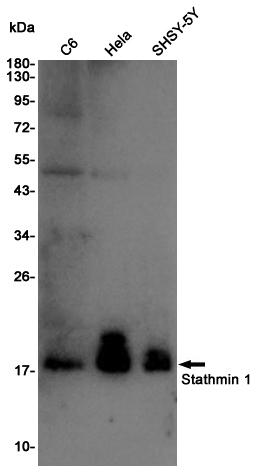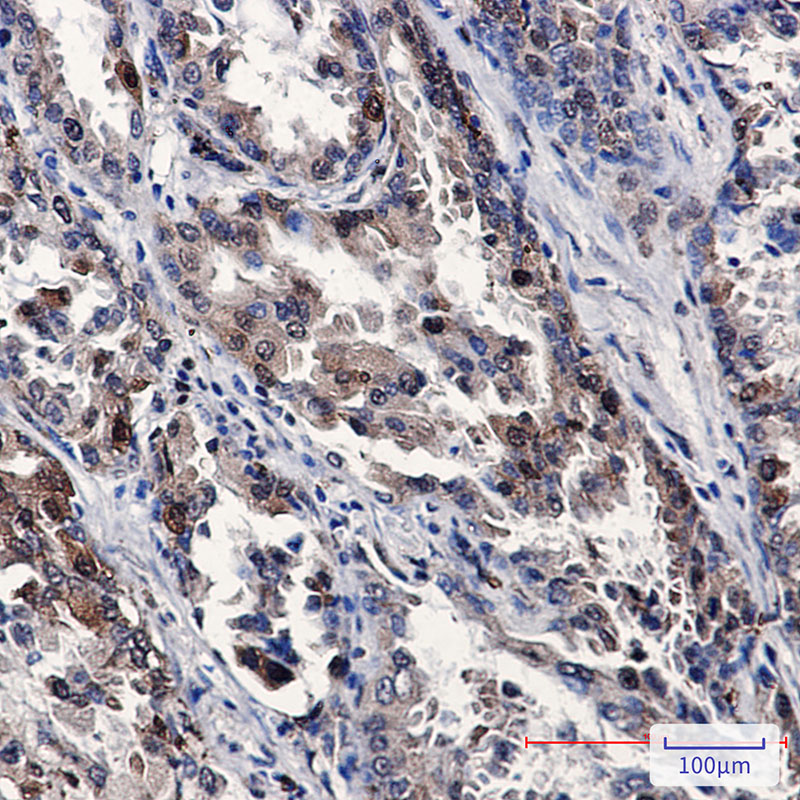

| WB | 咨询技术 | Human,Mouse,Rat |
| IF | 1/20 | Human,Mouse,Rat |
| IHC | 1/50-1/100 | Human,Mouse,Rat |
| ICC | 技术咨询 | Human,Mouse,Rat |
| FCM | 1/50-1/100 | Human,Mouse,Rat |
| Elisa | 咨询技术 | Human,Mouse,Rat |
| Aliases | STMN1; C1orf215; LAP18; OP18; Stathmin; Leukemia-associated phosphoprotein p18; Metablastin; Oncoprotein 18; Op18; Phosphoprotein p19; pp19; Prosolin; Protein Pr22; pp17 |
| Entrez GeneID | 3925 |
| WB Predicted band size | Calculated MW: 17 kDa; Observed MW: 17 kDa |
| Host/Isotype | Rabbit IgG |
| Antibody Type | Primary antibody |
| Storage | Store at 4°C short term. Aliquot and store at -20°C long term. Avoid freeze/thaw cycles. |
| Species Reactivity | Human,Rat |
| Immunogen | A synthetic peptide of human Stathmin 1 |
| Formulation | Purified antibody in TBS with 0.05% sodium azide,0.05%BSA and 50% glycerol. |
+ +
以下是3篇关于Stathmin 1(STMN1)抗体的代表性文献,按研究领域分类整理:
---
### 1. **癌症预后研究**
**文献名称**:*Stathmin 1 overexpression correlates with prognosis and immune infiltration in breast cancer*
**作者**:Li, X. et al. (2020)
**摘要**:通过免疫组化(使用抗STMN1抗体)分析乳腺癌组织中STMN1表达水平,发现其高表达与肿瘤分期、转移及患者生存率降低相关。研究提示STMN1可作为乳腺癌预后标志物及潜在治疗靶点。
---
### 2. **神经退行性疾病机制**
**文献名称**:*Stathmin-1 inhibition prevents tau hyperphosphorylation and microtubule disruption in Alzheimer's disease models*
**作者**:Manna, T. et al. (2018)
**摘要**:利用STMN1特异性抗体进行Western blot和免疫荧光,证实抑制STMN1可减少tau蛋白异常磷酸化并稳定微管结构,为阿尔茨海默病的病理机制提供了新见解。
---
### 3. **抗肿瘤药物开发**
**文献名称**:*Targeting Stathmin 1 with a monoclonal antibody inhibits ovarian cancer progression in vivo*
**作者**:Chen, R. et al. (2021)
**摘要**:开发了靶向STMN1的人源化单克隆抗体,通过体内实验证明其能显著抑制卵巢癌细胞增殖和转移,并增强化疗敏感性,为抗体疗法提供了 preclinical 证据。
---
**备注**:如需扩展文献或获取全文链接,可进一步提供具体需求。建议通过PubMed(https://pubmed.ncbi.nlm.nih.gov)输入**"Stathmin 1 antibody"**或结合研究主题关键词进行深度检索。
Stathmin 1. also known as oncoprotein 18 (OP18), is a ubiquitously expressed cytosolic protein involved in regulating microtubule dynamics by promoting depolymerization or preventing polymerization of tubulin. It acts as a critical regulator of cell cycle progression, intracellular transport, and signal transduction. Structurally, stathmin 1 contains phosphorylation sites that modulate its activity in response to cellular signals, influencing interactions with tubulin heterodimers. Its expression is tightly linked to cell proliferation and differentiation, making it a key player in both physiological and pathological processes.
In cancer research, stathmin 1 is frequently overexpressed in malignancies such as leukemia, breast, ovarian, and prostate cancers, where it correlates with aggressive tumor behavior, metastasis, and poor prognosis. Its role in promoting mitotic spindle instability and enhancing cell migration underscores its potential as a therapeutic target. Conversely, reduced stathmin 1 levels are observed in neurodegenerative disorders like Alzheimer’s disease, likely due to impaired neuronal plasticity and axonal transport.
Stathmin 1 antibodies are essential tools for detecting and quantifying the protein in research and diagnostics. They are widely used in techniques like Western blotting, immunohistochemistry (IHC), and immunofluorescence (IF) to study its expression patterns, subcellular localization, and phosphorylation status. These antibodies also facilitate investigations into stathmin 1’s functional interactions and its regulatory mechanisms in disease models. Validated antibodies with high specificity are critical for advancing studies on stathmin 1’s role in cancer progression, neurological disorders, and potential therapeutic interventions.
×